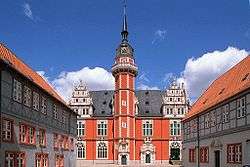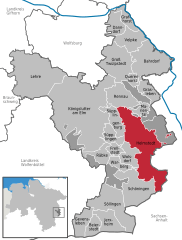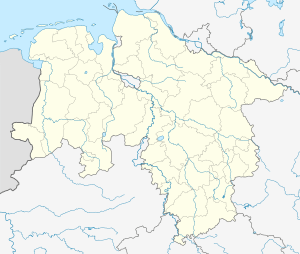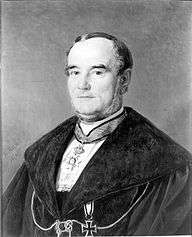Helmstedt
Helmstedt (German pronunciation: [ˈhɛlmˌʃtɛt]) is a town on the eastern edge of the German state of Lower Saxony. It is the capital of the District of Helmstedt. The historic university and Hanseatic city conserves an important monumental heritage of Romanesque and Renaissance buildings, as well as numerous timber framed houses. During the German partition the nearby Bundesautobahn 2 was the site of the Helmstedt–Marienborn border crossing, the most important on the former inner German border as starting point of the shortest land route between West Germany and West Berlin.
Helmstedt | |
|---|---|
 Juleum Novum, building of the former University of Helmstedt | |
 Coat of arms | |
Location of Helmstedt within Helmstedt district   | |
 Helmstedt  Helmstedt | |
| Coordinates: 52°13′41″N 11°00′38″E | |
| Country | Germany |
| State | Lower Saxony |
| District | Helmstedt |
| First mentioned | 952 |
| Subdivisions | 8 Boroughs |
| Government | |
| • Mayor | Wittich Schobert (CDU) |
| Area | |
| • Total | 66.54 km2 (25.69 sq mi) |
| Elevation | 123 m (404 ft) |
| Population (2018-12-31)[1] | |
| • Total | 25,728 |
| • Density | 390/km2 (1,000/sq mi) |
| Time zone | CET/CEST (UTC+1/+2) |
| Postal codes | 38350 |
| Dialling codes | 05351 |
| Vehicle registration | HE |
| Website | www.stadt-helmstedt.de |
Geography
Helmstedt is situated in a basin between the Elm and Lappwald hill ranges, at the transition area between the northern foothills of the Harz mountains and the North German Plain. It is surrounded by the Elm-Lappwald Nature Park. The town centre is located about 36 kilometres (22 mi) east of Braunschweig, 45 kilometres (28 mi) west of Magdeburg, and 90 kilometres (56 mi) east of the state capital Hanover.
The municipal area includes the localities of Barmke and Emmerstedt, both incorporated by a 1974 administrative reform, and Büddenstedt, incorporated in 2017, as well as the resort town of Bad Helmstedt, about 3.5 kilometres (2.2 mi) east of the town centre. Helmstedt currently has about 25,000 inhabitants (2015).
History
The settlement in the Duchy of Saxony was first mentioned as Helmonstede in a 952 deed issued by the German king Otto I. In former times also called Helmstädt, the town developed in the vicinity of the Benedictine St. Ludger's Abbey that was founded around 800 by Saint Liudger as a mission station. Helmstedt's town privileges were documented in 1247. It belonged to the Abbacy of Werden until 1490, when it was bought by the Duchy of Brunswick-Lüneburg. From 1576 to 1810, the University of Helmstedt was located here.
From the late 1940s to 1990, the town was the site of a major border crossing between the Federal Republic of Germany and the German Democratic Republic. The main rail and autobahn route between West Germany and Berlin, across the GDR, began at the Helmstedt–Marienborn border crossing, also known as Checkpoint Alpha. Official military traffic from NATO countries to West Berlin was only allowed to use this route.
Transport
The town lies on the Brunswick-Magdeburg railway.
 Mayor's office (built 1904 - 1906)
Mayor's office (built 1904 - 1906)- The "Owl Tower" of the medieval town wall
 The Hausmannsturm of Helmstedt
The Hausmannsturm of Helmstedt Memorial to the former border between West and East Germany
Memorial to the former border between West and East Germany
Famous citizens

- Franz Heinrich Ludolf Ahrens, (1809-1881), philologist
- Bibiana Beglau, (born 1971), actress
- Victor von Bruns, (1812–1883), physician and plastic surgeon
- Georg Fein (1803–1869), journalist and democratic politicians of Vormärz, founder and organizer of Workers' Educational Association s
- Peter Feldmann (born 1958), politician, mayor (SPD) of Frankfurt since 2012
- Johann Andreas Graeffer (1746–1802) botanist and nurseryman remembered by garden historians as having introduced a number of exotic plants to British gardens
- Johann Christian Friedrich Heyer (1793–1873), the first missionary who was sent abroad by Lutherans in the US
- Hans Krebs, (1898–1945), military officer and chief of staff of the Wehrmacht
- Rudolf Leuckart, (1822–1898), biologist and founder of parasitology
- Anton August Heinrich Lichtenstein, (1753-1816), zoologist and librarian
- Johann Heinrich Meibom (1590–1655), German physician and professor of medicine at the University of Helmstedt
- Karl Reinhard (1769–1840), writer and editor of the Göttingen Musenalmanachs
- Stefan Rinke (* 1965), historian and specialist in Latin American history
- Theodor von Schubert (1758–1825), astronomer
- Paul Gottlieb Werlhof (1699–1767), Royal Hanoverian court physician and poet
- Andree Wiedener, (born 1970), footballer, last active for Eintracht Frankfurt
In addition, see the list of famous students and professors of the University of Helmstedt.
Twin towns - sister cities
Helmstedt is twinned:[2]








References
- Chisholm, Hugh, ed. (1911). . Encyclopædia Britannica (11th ed.). Cambridge University Press.
- Landesamt für Statistik Niedersachsen, LSN-Online Regionaldatenbank, Tabelle 12411: Fortschreibung des Bevölkerungsstandes, Stand 31. Dezember 2018.
- "Partnerstädte". stadt-helmstedt.de (in German). Helmstedt. Retrieved 2019-12-03.
External links
| Wikimedia Commons has media related to Helmstedt. |
- Official website

- District Emmerstedt (in German)
- Helmstedt-CITYTOUR (photo-gallery)
- Map of Helmstedt
- Photos and information on Helmstedt's role in Allied military rail operations in 1969-70
- Riding with the locomotive engineer (engine driver) across the former intra-German frontier in 2005